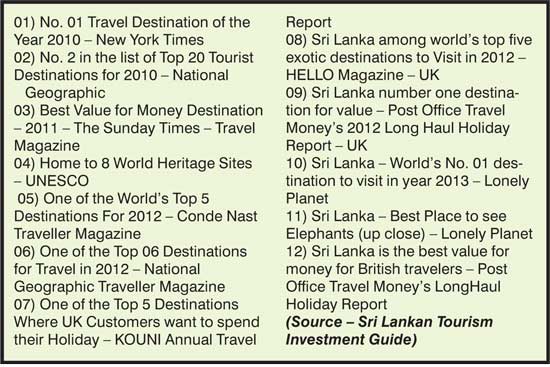Sunday Dec 07, 2025
Sunday Dec 07, 2025
Friday, 15 May 2015 00:00 - - {{hitsCtrl.values.hits}}
We are celebrating a rich history of thousands of years. The geodemographic importance of the country is one of its competitive advantages in tourism. Sri Lanka has been endorsed by many eminent personalities from different parts of the world during its past. The following remarks are good examples of this:
“The finest island in the whole world ” - Marco Polo, Italian merchant traveller from the Republic of Venice (1254-1324).
” - Marco Polo, Italian merchant traveller from the Republic of Venice (1254-1324).
“The people of various countries heard how pleasant the land was and flocked to it in numbers till it became a great nation. The climate is temperate and attractive without any difference of summer and winter. The vegetation is always luxuriant. Cultivation proceeds whenever men think fit: there are no fixed seasons for it” - Fa-Hsien: A Record of the Buddhistic Kingdoms (394-414 CE).
Let’s look at the following remarks made by the late science fiction writer Arthur C. Clark about Sri Lanka in an interview with Tasha Robinson which reveals the essence of what this country can offer the world.
Q: What appealed you about this country (Sri Lanka)?
A: “The quick answer I give to people who ask me about Sri Lanka is, ‘30 English winters’. So it’s a beautiful country. Historically, very interesting in every respect, very nice people. All of my friends are here now.” (Source - The Onion A.V. Club interview)
These endorsements are very important and the country should exploit its full potential in terms of attracting and retaining tourists. Furthermore, after the defeat of terroris m in 2009, a strategic window has opened for Sri Lanka and many international bodies in the tourism industry have accredited the country (see Box 1).
m in 2009, a strategic window has opened for Sri Lanka and many international bodies in the tourism industry have accredited the country (see Box 1).
As suggested in the ‘Resource Based View (RMV)’ in Strategic Management, there is a special consideration for valuable tangible or intangible resources to achieve a competitive advantage. Yet, the strategies used by different countries should also be identified. I think we have to see the potentials of the concept of ‘Wall Paintings’ in this context.
Again we have a product history of wall paintings in different places throughout the country. In this scenario, Sigiriya is one of the ‘wonders’ in wall paintings. The most renowned are the Sigiriya Rock Paintings or Frescoes of Sigiri damsels locally called ‘ Sigiri Apsaras’, painted on a western rock face cavity about 100 meters high from the rock base. This is a great tourist attraction in Sri Lanka.
But at present, the concept of wall pai

ntings has undergone changes and different countries use the concept in different ways to attract tourists. There is one case study we can discuss on wall paintings in Penang, Malaysia. There are many wall paintings you can see and ‘Little Children on a Bicycle’ - The Mural, Armenian Street, George Town, Penang is a great tourist attraction among them.
These old walls in the town have gained a new lease of life with creativity and imagination. Once you read more on this, the Lithuanian artist Ernest Zacharevic is leaving his mark with a beautiful wall painting of children across historical Georgetown. The artworks are funny, fascinating and open to everyone’s interpretation.
Ninety percent of tourists who arrive in Penang, Malaysia visit these places and take photos to record their great memories of the city of Penang. This is actually a marketing tool to position your country. The wall paintings can be considered as one of the Key Successive Factors (KSF) of the city. If someone compares tourists arrivals between Sri Lanka and Penang, (keep in mind Penang is only one city in Malaysia), Penang has more than double the number of visitors than Sri Lanka and the city is famous for food with many attractions, and the wall painting is one addition to that.
There should be proper strategies to market the country. Different segments should be identified and I think Sri Lanka can also benchmark wall paintings of Penang as one strategy. Expectations of  segments can be varied and clusters like Generation Y (people who were born after 1985) are really important as it is growing with social media and innovators. The policies need to be revised with innovative ideas while maintaining our culture, heritage and dignity.
segments can be varied and clusters like Generation Y (people who were born after 1985) are really important as it is growing with social media and innovators. The policies need to be revised with innovative ideas while maintaining our culture, heritage and dignity.
(The writer is Senior Lecturer and Chartered Marketer – Open University of Sri Lanka. You can reach Dr. Abeysekera on [email protected])